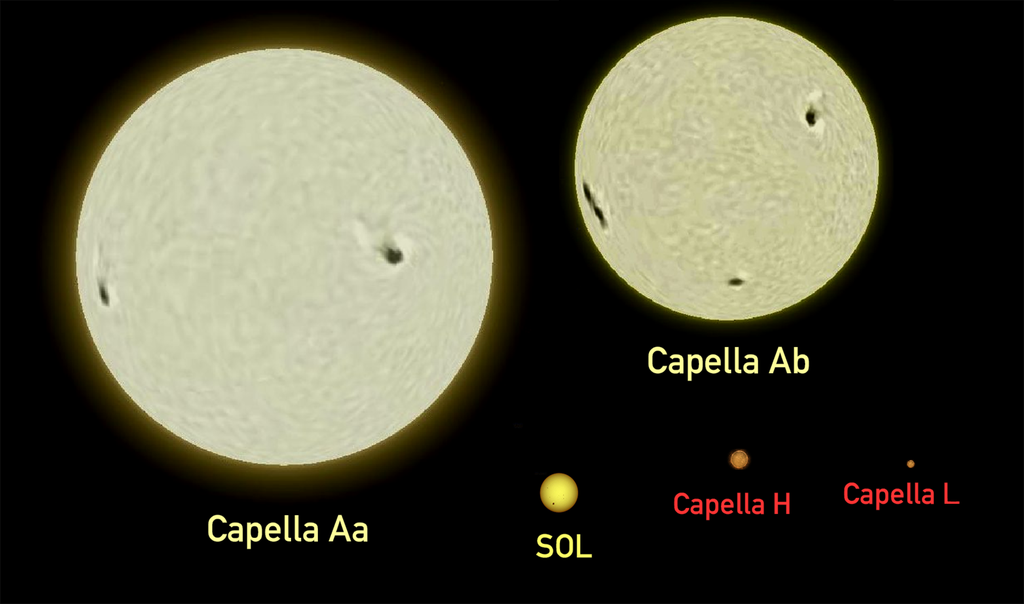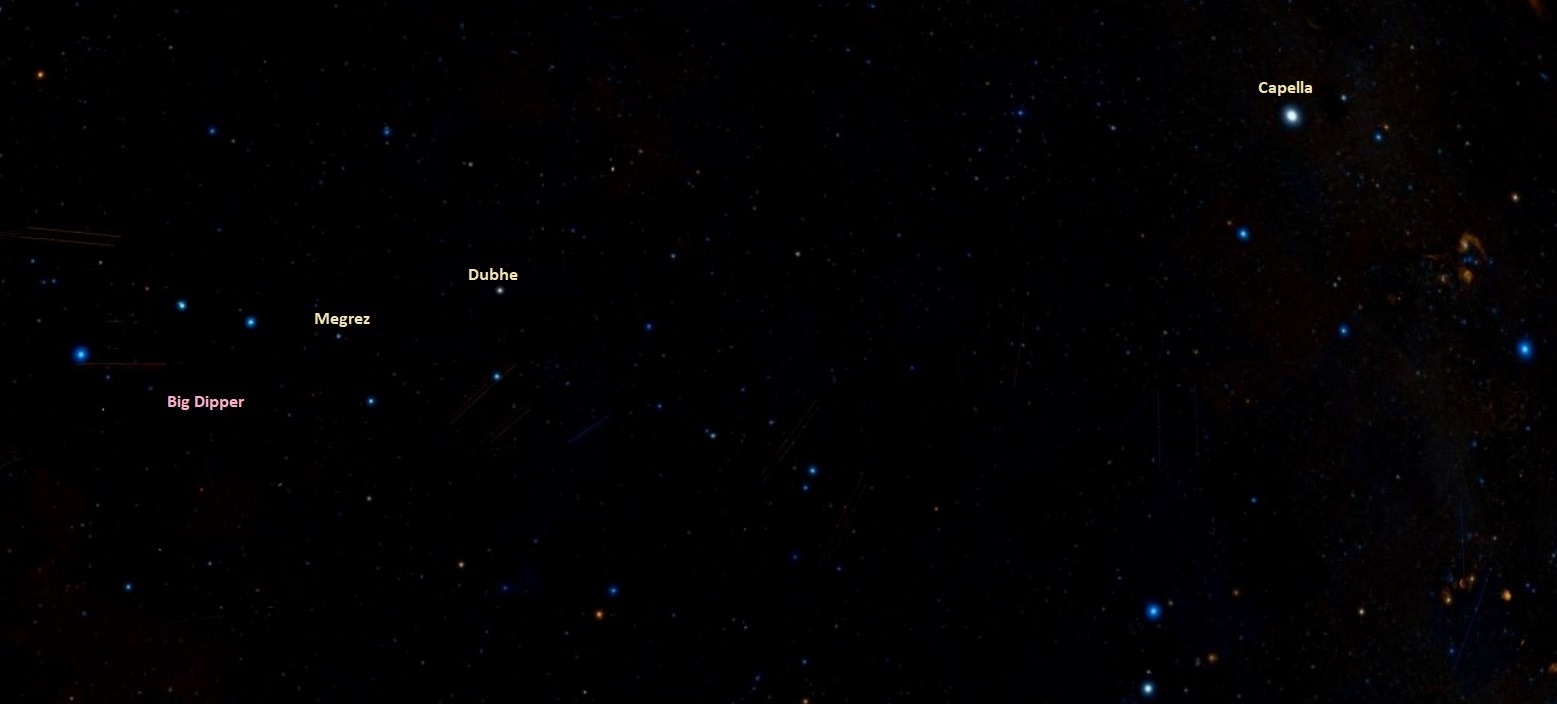Capella, Alpha Aurigae (α Aur), is a quadruple star system located in the constellation Auriga, the Charioteer. It is the brightest star in Auriga and the sixth brightest star in the sky. With a combined apparent magnitude of 0.08, it outshines the bright Rigel in the constellation Orion, Procyon in Canis Minor, and Achernar in Eridanus, and is the third brightest northern star, after Arcturus and Vega. Capella lies at an approximate distance of 42.9 light years from Earth. The two brighter components of its system – Capella Aa and Capella Ab – are both individually first-magnitude stars. With magnitudes of 0.76 and 0.91, they are both among the 15 brightest stars in the sky.
Star system
Capella may appear as a single star to the unaided eye, but it is in fact a multiple star system consisting of two pairs of stars. The four components are designated Capella Aa, Capella Ab, Capella H, and Capella L. The brighter Capella Aa and Capella Ab form one binary pair and the fainter Capella H and L, the other. The pairs are separated by about 723’’ or 9,500 astronomical units.
Capella A
The brighter pair, the components Aa and Ab, are giant stars of the spectral types K0III and G1III. Their composite spectral class is G3III. The stars orbit each other with a period of 104.02128 days at a separation of only 0.74272 astronomical units, or roughly the distance from the Sun to Venus.
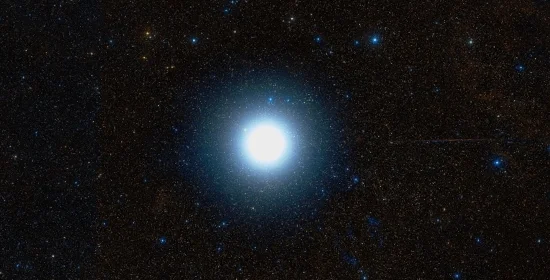
Capella (Alpha Aurigae), image: Wikisky
Capella Aa, a yellow-orange giant (the spectral class given for the star is K0III or G8-K0 IIIe), has a mass 2.5687 times that of the Sun and a radius 11.98 times solar. With an effective temperature of about 4,970 K, it is 78.7 times more luminous than the Sun. The star is a relatively slow spinner and, with a projected rotational velocity of 4.1 km/s, it takes 104 ± 3 days to complete a rotation. At its largest, the star is believed to have expanded into a size 36 to 38 times that of the Sun. Now, it is fusing helium to carbon and oxygen in its core and, as it approaches the end of this phase, it is beginning to expand again before it moves to the asymptotic giant branch (AGB).
Even though it is given the luminosity class of a giant, the binary companion is still a subgiant star currently in the process of evolving into a red giant. It has a mass of 2.4828 solar masses and a size of 8.83 solar radii. It shines with 72.7 solar luminosities and has a surface temperature of 5,730 K. Capella Ab is a much faster spinner than Capella Aa. It rotates with a velocity of 35 km/s, taking 8.5 ± 0.2 days to complete a rotation.
The stars are believed to be between 590 and 650 million years old. Both were once white, class A main sequence stars and will next become red giants. Neither star is massive enough to go out as a supernova. Instead, when they reach the end of their life cycles, the stars will expel their outer layers as planetary nebulae, leaving behind planet-sized white dwarfs, much like the companions of Sirius and Procyon, that will gradually fade.
The components of Capella A do not constitute an eclipsing binary system – the stars do not eclipse each other as they orbit as seen from Earth. They are almost equally bright, with the component Ab generally found to be a little brighter at visual wavelengths, but only by a few tenths of a magnitude. Capella Aa is more luminous overall, when all wavelengths are taken into account.
Capella A is slightly variable, showing variations in brightness of about 0.1 magnitudes. The General Catalogue of Variable Stars lists it only as a suspected variable, but the star system is classified as an RS Canum Venaticorum (RS CVn) variable. RS CVn stars are close binary systems with active chromospheres that can cause large stellar spots which, in turn, cause variations in luminosity. The stars’ brightness typically varies by about 0.2 magnitudes. Other than the prototype (RS CVn), stars in this class include Achird (Eta Cassiopeiae), Alula Australis (Xi Ursae Majoris), Zeta Andromedae, Lambda Andromedae, Epsilon Ursae Minoris, and Omicron Draconis.
Capella HL
The secondary pair in the Capella system, Capella HL, consists of two main sequence dwarfs considerably less massive than the Sun. Both stars are red dwarfs with the stellar classifications M2.5 V (Capella H) and M4 (Capella L). Capella H has 0.57 solar masses, while Capella L has 0.53 solar masses. Capella H is almost half the size of the Sun, with a radius of 0.54 solar radii. With a surface temperature of 3,700 K, it shines with only 0.05 solar luminosities. At the time of discovery (1935), Capella H and Capella L were separated by 1.8’’, but the separation increased to 3.5’’ (40 astronomical units) 80 years later. The stars orbit each other with a period of 300 years.
Capella H and Capella L are sometimes referred to as Capella C and Capella D because the designations B through G refer to stars unrelated to the Capella system.
Capella has several visual companions located within a few arcminutes. The Washington Double Star Catalog (WDS) lists stars designated Capella A, B, C, D, E, F, G, H, I, L, M, N, O, P, Q and R. Most of the companions merely lie in the same line of sight as Capella A. The components H and L are the exception, as they lie at approximately the same distance as Capella and have similar proper motion. However, the physical companions appear further away from Capella A than the six line-of-sight companions designated Capella B, C, D, E, F and G, discovered before Capella H.
Facts
Capella is one of the six exceptionally bright stars that form the Winter Hexagon (Winter Circle), a prominent asterism that dominates the evening sky during the northern hemisphere winter. The other stars that form the asterism are Sirius (the brightest star in the sky) in Canis Major, Procyon (the eighth brightest star) in Canis Minor, Pollux (the 17th brightest star) in Gemini, Aldebaran (the 14th brightest star) in Taurus, and Rigel (the seventh brightest star) in Orion.
Capella is also part of a smaller hexagon formed by the brightest stars of Auriga and Elnath in Taurus.
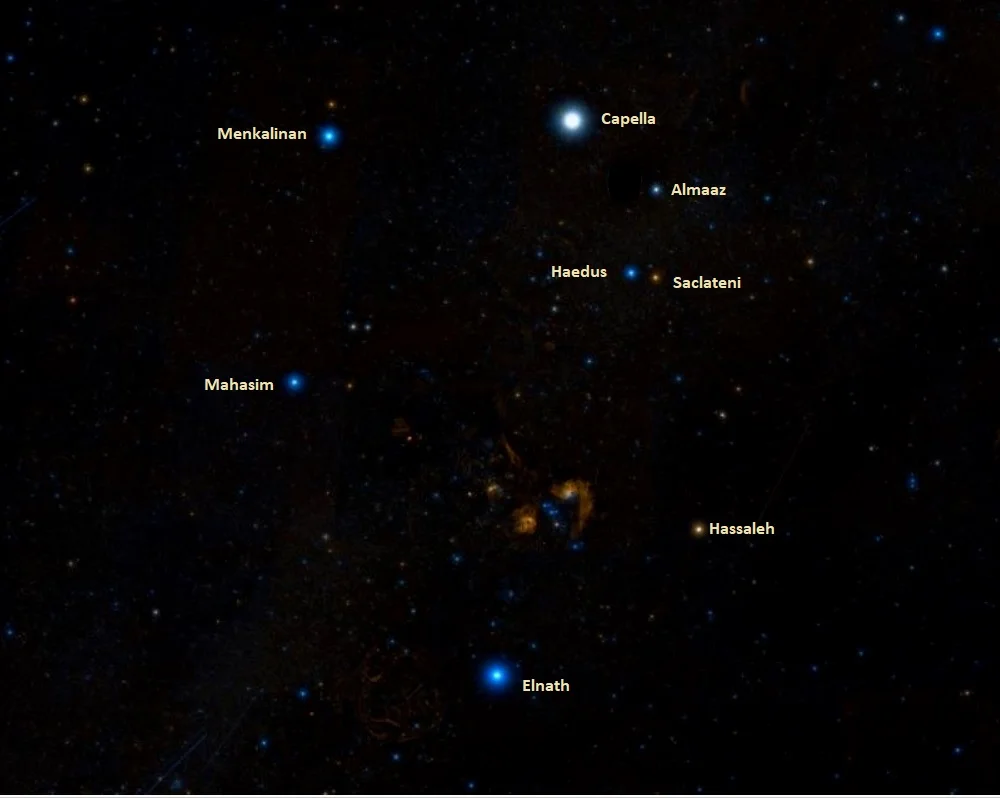
Auriga stars, image: Wikisky
The stars Zeta and Eta Aurigae, formally named Saclateni and Haedus, are known as the Haedi, the kids of the she-goat Capella. Zeta Aurigae was traditionally known as Haedus I and Eta Aurigae as Haedus II. The star Epsilon Aurigae, appearing between Capella and the kids, is traditionally known as Almaaz, “the billy goat.” The three Haedi were regarded as a separate constellation by the Roman authors Pliny the Elder and Manilius in the 1st century CE. They called the constellation Capra (female goat), Caper or Hircus (male goat). The Greco-Roman astronomer Ptolemy merged the goat constellation with the Charioteer when he listed the 48 Greek constellations in his Almagest in the 2nd century CE. Some depictions of Auriga still show the Charioteer holding a goat on his left shoulder and the goat’s kids under his arm.
Capella and the other stars of the Winter Hexagon are among the 58 bright stars selected for navigation. Navigational stars are among the brightest and most recognizable stars in the sky. Selected by Her Majesty’s Nautical Almanac Office and the US Naval Observatory, they have a special status in the field of celestial navigation and span the area from the declination -70° to +89° of the celestial sphere. Capella is the only navigational star in the constellation Auriga.
Capella was once the brightest star in the sky. It held the title from 210,000 years ago to 160,000 years ago and reached a peak brightness of -0.82 (slightly brighter than Canopus is today), when it came within 27.9 light years of the solar system. Even at its peak, the star was considerably fainter than Sirius is today (mag. -1.46). Capella was succeeded by Canopus in the southern constellation Carina. Canopus held the title of the brightest star three times in the last 5 million years, most recently before Sirius took over about 90,000 years ago.
The multiple nature of Capella was discovered by two astronomers independently in 1899. The American astronomer William Wallace Campbell studied photographic plates taken between August 1896 and February 1897 and found that a second spectrum appeared superimposed over the first, also noting doppler shifts to violet and then to red, indicating that the component stars were orbiting each other, i.e. moving toward and away from the Earth. In July 1899, British astronomer Hugh Newall observed the star with a four-prism spectroscope on a 25-inch telescope at Cambridge and, studying its composite spectrum, also came to the conclusion that it was a binary system.
The first astronomers to resolve Capella interferometrically were John Anderson and Francis Pease. In 1919, they studied the star from Mount Wilson Observatory in California and published an orbit for the system in 1920. Capella was the first object outside our solar system to be measured interferometrically.
The binary system was discovered to have a dim companion in 1914 by the Finnish astronomer Ragnar Furuhjelm. The companion shared a similar proper motion with the brighter pair, indicating that it was physically associated with Capella Aa and Capella Ab. American astronomer Carl Leo Stearns noted that the companion was a binary star itself in February 1936. His conclusion was confirmed several months later, in September 1936, by the Dutch astronomer Gerard Kuiper. The components of the second pair are designated Capella H and Capella L.
In 1994, a team of astronomers at Mount Wilson Observatory determined a high precision orbit for the components Aa and Ab using the Mark III Stellar Interferometer.
In September 1995, Capella was imaged by the Cambridge Optical Aperture Synthesis Telescope (COAST), located at the Mullard Radio Astronomy Observatory in Cambridgeshire, England. COAST is a multi-element optical interferometer, the first long-baseline interferometer to produce high-resolution images of stellar surfaces outside the solar system by collecting light from three separate telescopes. The images were the first to show the motions of Capella Aa and Ab, which cannot be resolved by conventional telescopes. Capella was the first object outside the solar system to be imaged by a separate element optical interferometer and the images were the first ever obtained from an interferometric array of optical telescopes.
Capella is the third brightest star in the northern celestial hemisphere. It is only slight fainter than Arcturus (mag. -0.05) in the constellation Boötes and Vega (mag. 0.026) in Lyra. For observers in mid-northern latitudes (40° N), who cannot see Canopus and Alpha Centauri due to their location in the far southern sky, Capella is the fourth brightest star in the sky.
Capella is the closest first-magnitude star to the north celestial pole. It lies on the opposite side of the pole to Vega at roughly the same distance. A line drawn from Capella to Vega would almost pass through the North Star, Polaris.
Capella’s nearest neighbours are the red dwarf L 1672-14 (3.9 light years away), the yellow main sequence star Lambda Aurigae (4.5 light years), and the orange main-sequence star G 81-39 (5.4 light years).
Capella is one of the brightest stars in X-ray wavelengths, with an X-ray luminosity about 10,000 times that of the Sun. The X-ray emissions are believed to come mainly from the corona of the primary component in the system, Capella Aa, which is also considerably more variable than the corona of the component Ab. The X-ray emissions were detected on April 5, 1974, when a rocket flight calibrated its attitude control system after a star sensor pointed the payload axis at the star. The event marked the beginning of stellar X-ray astronomy.
In Mesopotamian astronomy, Capella was associated with a constellation known as “GAM,” “Gamlum” or “MUL.GAM,” mentioned in the Babylonian compendium MUL.APIN in the 7th century BCE. GAM was associated with a scimitar or crook and the name may have referred to Capella alone or to the constellation Auriga as a whole. The star itself is believed to have been mentioned in an Akkadian inscription written as early as in the 20th century BCE. In Akkadian times, Capella may have been Dil-gan I-ku, meaning “the messenger of light,” or Dil-gan Babili, the patron star of Babylon. In Sumerian, it was called mul.ÁŠ.KAR, meaning “the goat star,” and in Assyria it was known as I-ku, “the leader,” meaning the leader of the year. The start of the year is believed to have been determined by Capella’s position relative to the Moon at the vernal equinox before 1730 BCE, when the Sun entering the constellation Taurus marked the beginning of spring.
Building J of the archaeological site Monte Albán in Oaxaca Valley in southern Mexico, constructed around 175 BCE, is suspected to have been built with respect to Capella’s heliacal rising, at a different orientation to other buildings on the site. A line perpendicular to the base of the steps at the building’s entrance would have pointed directly to the star. Capella’s heliacal rising – brief appearance above the eastern horizon at dawn after a period of invisibility – took place on one of the days when the Sun passed directly overhead over the site.
A number of ancient temples are believed to be oriented to Capella, including the sanctuary of Ptah in Memphis, Egypt and the Temple of Diana Propylaea at Eleusis, Greece.
Throughout history, Capella was commonly used in navigation and timekeeping. The Gwichʼin people of Canada and Alaska saw the star and its neighbour Menkalinan as shreets’ą įį vidzee, the right ear of Yahdii, a circumpolar constellation that stretched across much of the sky and helped them navigate and keep time at night. The Inuit saw Capella as part of a constellation called Quturjuuk, “collar-bones,” formed by two pairs of stars (Capella and Menkalinan, Pollux and Castor) that each represented a bone.
In medieval astrology, Capella was one of the Behenian fixed stars, believed to be a source of special astrological power. Each of the 15 Behenian stars was connected with one or more planets, a plant and a gemstone, and the latter two were used in rituals to bring out the star’s influence. Capella was associated with the planets Jupiter and Saturn and linked with sapphire and thyme. It was believed to bring wealth as well as civic, political and military honours.
Like other bright stars, Capella has been used or referenced in countless works of fiction. Notable mentions include the novels The Exiles of Capella (Os Exilados da Capela, 1949) by Edgard Armond, Lone Star Planet (1958) by H. Beam Piper, Robert A. Heinlein’s Starship Troopers (1959), Jack Vance’s Emphyrio (1969), James Gunn’s The Listeners (1972), Philip José Farmer’s Time’s Last Gift (1972), Christopher Evans’ Capella’s Golden Eyes (1980), Stewart Cowley’s Starliners: Commercial Travel in 2200 AD (1980), and Anne McCaffrey’s The Rowan (1990) novels. The star was also memorably used in the episode “Friday’s Child” of Star Trek: The Original Series.
Name
The name Capella (pronunciation: /kəˈpɛlə/) means “(small) female goat” in Latin. The star was once also known as Capra (Latin for “female goat”) and is still sometimes called the Goat Star. In English literature, it is often referenced as the Shepherd’s Star.
The name Capella was officially approved by the International Astronomical Union’s (IAU) Working Group on Star Names (WGSN) on June 30, 2016. It formally applies only to the component Alpha Aurigae Aa, but is commonly used for the entire star system and its other individual components (Capella Ab, Capella H, Capella L).
Capella has been associated with a goat for millennia. The Greeks associated it with Amalthea, the goat that nursed the infant Zeus. In the myth, Zeus accidentally broke off the goat’s horn and the horn was transformed into cornucopia, the horn of plenty, which had the power to provide unending nourishment and would be filled with whatever the owner desired.
In Bedouin astronomy, Auriga stars represented a herd of goats. The Bedouin in Sinai and Negev called Capella al-‘Ayyūq ath-Thurayyā, “Capella of the Pleiades.”
Capella has been known by many other names in different cultures throughout history. In the Middle Ages, it was known as Alhajoth, which was possibly a corruption of the star’s Arabic name, al-cayyūq, which in turn may have been derived from the Greek αίξ, meaning “goat.” In Arabic astronomy, the star was also commonly known as Al-Rākib, meaning “the driver.” This was a translation from the Greek and referred to the star’s prominent position in the sky, becoming visible before other stars in the evening, and appearing to watch over them.
The Chinese know Capella as the Second Star of the Five Chariots (五車二). Five Chariots is a Chinese constellation also formed by Menkalinan (Beta Aurigae), Hassaleh (Iota Aurigae), Mahasim (Theta Aurigae) and Elnath (Beta Tauri). These are the same stars that form Auriga’s pentagon asterism.
In Hindu astronomy, Capella was called Brahma Hṛdaya, “the heart of Brahma.”
Baltic people called Capella Tikutis or Perkūno Ožka, meaning “thunder’s goat.” Slavic Macedonians knew it as Jastreb, “the hawk,” ready to swoop on the Mother Hen, represented by the Pleiades cluster, and the Rooster, represented by the star Elnath.
In ancient Peru, Quechua people knew the star as Colça and associated it with the affairs of shepherds.
In Tahitian mythology, Capella was known as Tahi-ari’I, the mother of prince Ta’urua (represented by the planet Venus), who sails across the sky in his canoe. In Hawaii, the star was part of an asterism called Ke ka o Makali’I, meaning “the canoe bailer of Makali’I,” which was used in navigation at sea. The asterism was also formed by the bright Sirius, Procyon, Pollux and Castor.
In the Marshall Islands, Capella represented Ligedaner, the mother of stars. In local lore, Ligedaner told her sons that the one who wins the race to an eastern island would become the King of the Stars, and asked her eldest son, Dümur (represented by Antares), to let her come in his canoe. Dümur and all the other sons except the youngest refused and the youngest son, represented by the Pleiades, won the race and became the King of the Stars. In the Caroline Islands, Capella was known as Jefegen uun, meaning “north of Aldebaran.” In the Society Islands, it was called Tahi-anii, meaning “unique sovereign.”
The Boorong people of northwestern Victoria in Australia called Capella Purra, the kangaroo. The kangaroo met its end at the hands of the twins Yurree and Wanjel, represented by the Gemini stars Castor and Pollux. The Wardaman people of the Northern Territory of Australia knew Capella as Yagalal, a ceremonial fish scale.
Location
Capella is quite easy to find because it lies in a region of the sky particularly rich in exceptionally bright stars. Located about halfway between Polaris and Orion’s Belt, it is one of the six bright stars that form the Winter Circle, and the brightest of the stars that form Auriga’s conspicuous pentagon pattern. The small triangle of stars that form the Kids asterism makes Capella very easy to identify.
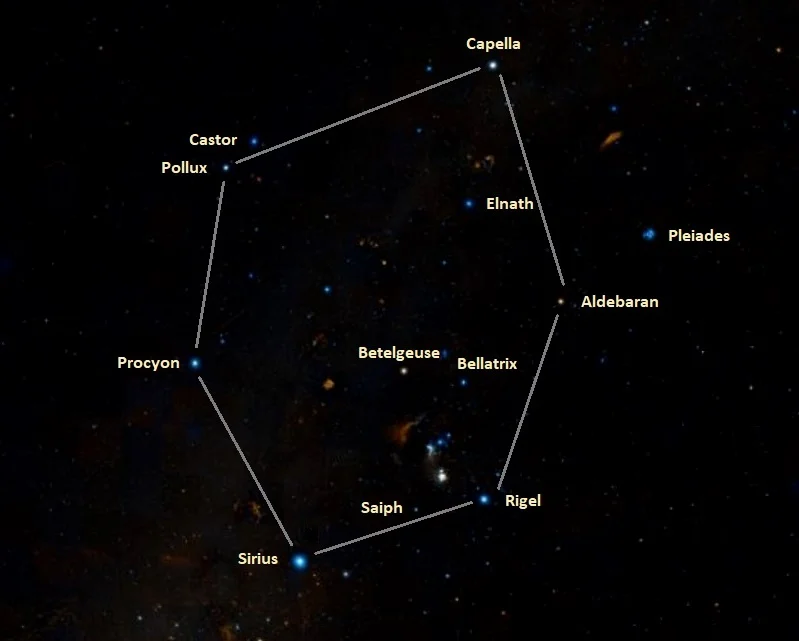
Auriga location, image: Wikisky
In less than ideal observing conditions, Capella can be found using the stars of the Big Dipper. A line extended from Megrez to Dubhe away from the Dipper’s handle points roughly in the direction of Capella.
Capella is circumpolar, i.e. it stays above the horizon year-round, to observers north of the latitude 44° N, while those living south of the latitude 44° S cannot see it all. The star reaches its highest point in the sky at midnight in early December.
Constellation
Capella is the luminary of the constellation Auriga. It marks the left shoulder of the celestial Charioteer or the goat held by the Charioteer over his shoulder. The constellation is associated with the mythical goat Amalthea, who nurtured the young Zeus, as well as with Erichthonius of Athens, the son of Hephaestus credited for inventing the four-horse chariot (the quadriga). Auriga is one of the 48 Greek constellations, first listed by the Greco-Roman astronomer Ptolemy of Alexandria in the 2nd century CE. It is one of the larger constellations, 21st in size, occupying an area of 657 degrees of the northern sky.
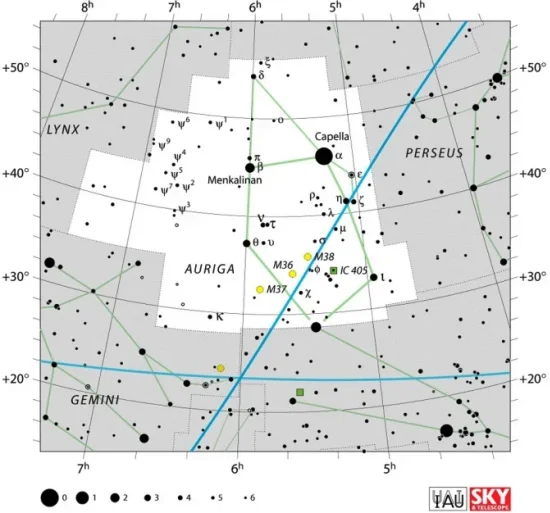
Auriga constellation map by IAU and Sky&Telescope magazine
Auriga is known for being home to Capella and several other notable variable stars, including the Algol-type eclipsing binaries Menkalinan (Beta Aurigae), Almaaz (Epsilon Aurigae), and Saclateni (Zeta Aurigae), the slow irregular variable Pi Aurigae, and Mahasim (Theta Aurigae), an Alpha2 Canum Venaticorum variable. The Orion variable AE Aurigae, an O-type main sequence star believed to be a runaway star from the Orion Nebula (M42), illuminates the Flaming Star Nebula, a magnitude 6.0 emission-reflection nebula located at a distance of about 1,500 light years from the Sun.
Auriga is also known for its bright open clusters Messier 36, Messier 37, Messier 38, NGC 2281, NGC 1664, and NGC 1893, the last of which is embedded in the faint H II region IC 410.
The best time of year to observe the stars and deep sky objects of Auriga is during the month of February.
The 10 brightest stars in the constellation are Capella (Alpha Aur, mag. 0.08), Menkalinan (Beta Aur, mag. 1.90), Mahasim (Theta Aur, mag. 2.62 – 2.70), Hassaleh (Iota Aur, mag. 2.69), Almaaz (Epsilon Aur, mag. 2.92 – 3.83), Haedus (Eta Aur, mag. 3.18), Saclateni (Zeta Aur, mag. 3.70 -3.97), Delta Aurigae (mag. 3.715), Nu Aurigae (mag. 3.957), and Pi Aurigae (mag. 4.25).
Capella – Alpha Aurigae
| Constellation | Auriga |
| Names and designations | Capella, Alpha Aurigae, α Aur, 13 Aurigae, Alhajoth, Hokulei, HD 34029, HR 1708, HIP 24608, GC 6427, GCRV 3121, FK5 193, SAO 40186, BD+45 1077, PPM 47925, LTT 11619, NLTT 14766, CCDM J05168+4559, ADS 3841, WDS 05167+4600, IDS 05093+4554, AAVSO 0509+45, TYC 3358-3141-1, CSV 100460, NSV 1897, EUVE J0516+45.9, IRAS 05130+4556, 2MASS J05164138+4559525 |
| Capella A | Alpha Aurigae A, GJ 194 |
| Capella HL | Capella CD, GJ 195 |
| Capella H | Capella C, GJ 195 A, GCRV 3130, PPM 47938, LTT 11622, NLTT 14788, 2MASS J05172386+4550229, Gaia DR2 211810233512673792, EUVE J0517+45.8, G 96-29 |
| Capella L | Capella D, GJ 185 B, VVO 238, 2MASS J05172394+4550198, Gaia DR2 211810233512673920 |
Capella A
| Spectral class | G3III (Aa: K0III, Ab: G1III) |
| Variable type | RS Canum Venaticorum (suspected) |
| U-B colour index | +0.44 |
| B-V colour index | +0.80 |
| V-R colour index | −0.3 |
| R-I colour index | +0.44 |
| Apparent magnitude | 0.08 (0.03 – 0.16) |
| Absolute magnitude (Capella Aa, Capella Ab) | +0.296, +0.167 |
| Distance | 42.919 ± 0.049 light years (13.159 ± 0.015 parsecs) |
| Parallax | 76.20 ± 0.46 mas |
| Radial velocity | +29.9387 ± 0.0032 km/s |
| Proper motion | RA: 75.52 mas/yr |
| Dec.: −427.11 mas/yr | |
| Mass (Capella Aa, Ab) | 2.5687 ± 0.0074 M☉, 2.4828 ± 0.0067 M☉ |
| Luminosity (Capella Aa, Ab) | 78.7 ± 4.2 L☉, 72.7 ± 3.6 L☉ |
| Radius (Capella Aa, Ab) | 11.98 ± 0.57 R☉, 8.83 ± 0.33 R☉ |
| Temperature (Capella Aa, Ab) | 4,970 ± 50 K, 5,730 ± 60 K |
| Metallicity | −0.04 ± 0.06 dex |
| Age | 590–650 million years |
| Rotational velocity (Capella Aa, Ab) | 4.1 ± 0.4 km/s, 35.0 ± 0.5 km/s |
| Rotation (Capella Aa, Ab) | 104 ± 3 days, 8.5 ± 0.2 days |
| Surface gravity (Capella Aa, Ab) | 2.691 ± 0.041 cgs, 2.941 ± 0.032 cgs |
| Right ascension | 05h 16m 41.35871s |
| Declination | +45° 59′ 52.7693″ |
Capella H
| Spectral class | M2.5 V |
| U-B colour index | 1.24 |
| B-V colour index | 1.50 |
| R-I colour index | 0.91 |
| Apparent magnitude | 10.16 |
| Absolute magnitude | 9.53 |
| Distance | 43.48 ± 0.02 light years (13.330 ± 0.007 parsecs) |
| Parallax | 75.02 ± 0.04 mas |
| Radial velocity (Capella HL) | 31.63 ± 0.14 km/s |
| Proper motion | RA: 88.57 mas/yr |
| Dec.: -428.91 mas/yr | |
| Mass | 0.57 M☉ |
| Luminosity | 0.05 L☉ |
| Radius | 0.54 ± 0.03 R☉ |
| Temperature | 3,700 ± 150 K |
| Metallicity | +0.1 dex |
| Surface gravity | 4.75 ± 0.05 cgs |
| Right ascension | 05h 17m 23.728s |
| Declination | +45° 50′ 22.97″ |
Capella L
| Spectral class | M4 |
| Apparent magnitude | 13.7 |
| Absolute magnitude | 13.1 |
| Distance | 43.44 ± 0.04 light years (13.32 ± 0.01 parsecs) |
| Parallax | 75.09 ± 0.07 mas |
| Radial velocity (Capella HL) | 31.63 ± 0.14 km/s |
| Proper motion | RA: 54.1 mas/yr |
| Dec.: -417.5 mas/yr | |
| Mass | 0.53 M☉ |
| Right ascension | 05h 17m 23.943s |
| Declination | +45° 50′ 19.84″ |
